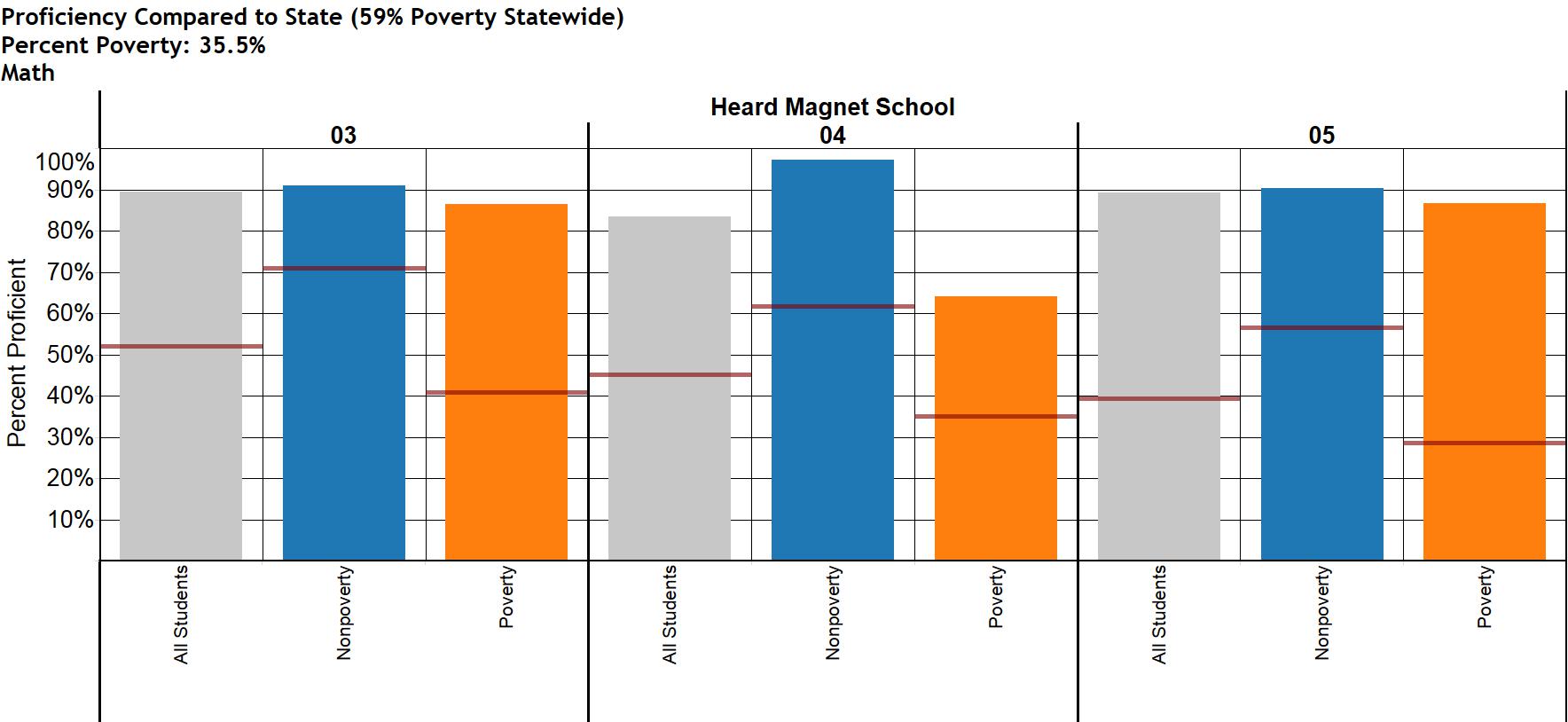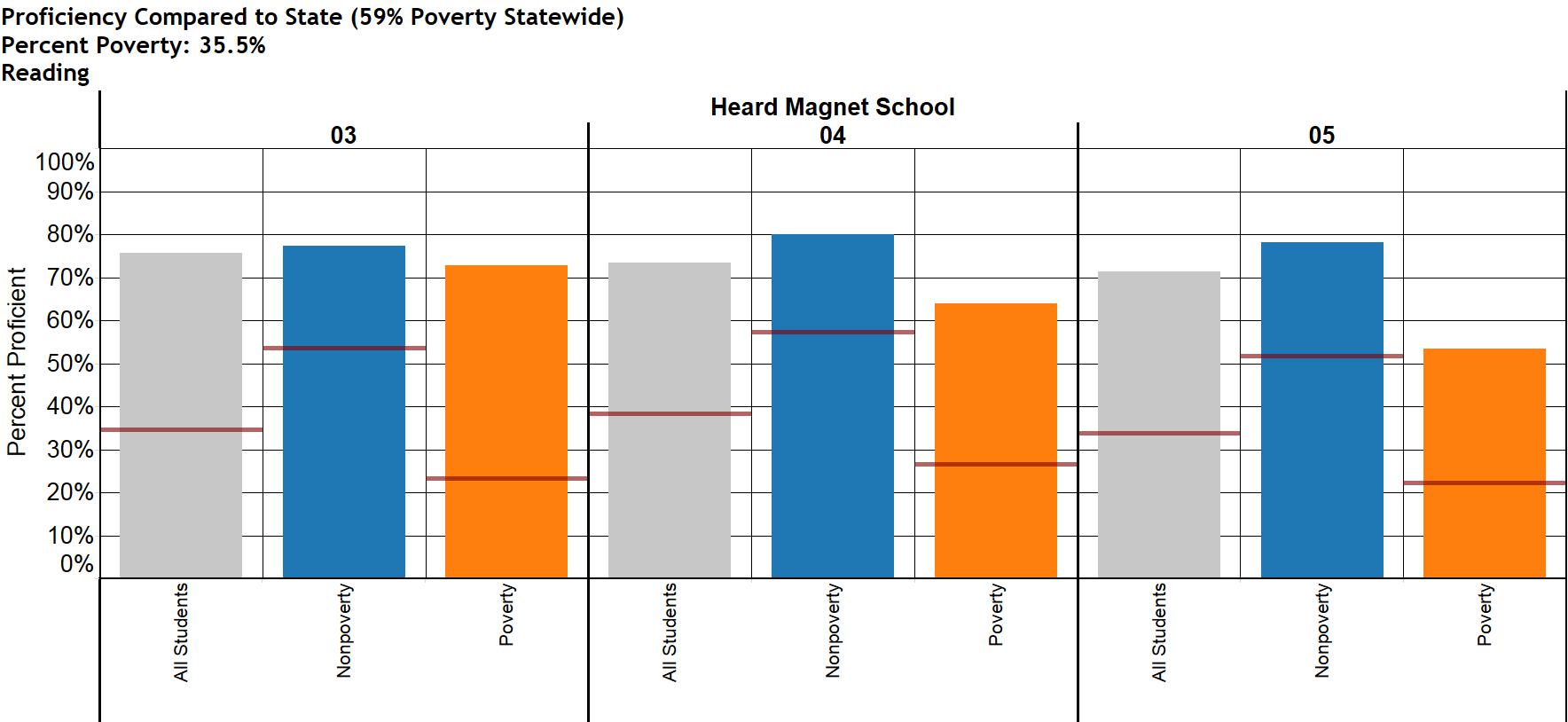Take a look at the 2014 ACT Aspire results for Heard Magnet Elementary school in Dothan.
The following images show the percentage of students at each grade level scoring proficient on the Aspire, the state’s standardized test. Students scoring proficient on the tests of math and reading are considered to be on track to advance through their academic career toward an ultimate goal of graduating from high school ready to succeed in college level coursework.
The charts show the results for All Students at the school and also display the results for students who qualify for the free or reduced lunch program (identified as “Poverty” in the chart), and also for the students who don’t qualify (“Nonpoverty”).


What do we see at Heard? Here are some important things to note:
1. High percentages of students are academically on track. The percentage of proficient students at Heard is far above the state average proficiency rate (The state average is represented by the red reference line).
2. The gaps in performance between students from poverty households and students from nonpoverty households are relatively small. In some grades, the success rate for poverty and nonpoverty students is practically the same.
Heard’s results are an exception. In general, across Alabama, there is about a 30-point gap between the success rate of nonpoverty and poverty students on these benchmark tests. That’s true in both reading and math. However, Heard’s results are proof that the performance gap is not inevitable. Similar results can be found in schools around the state.
It should also be noted that Heard has some advantages on these performance measures. It is a magnet school. It is drawing students and parents that have high expectations for academic success, which may mean that it isn’t working with the children who have the highest degree of disadvantage. Also, Heard’s student population doesn’t have the same concentration of poverty as other schools in the state. About 36 percent of Heard’s students are in the poverty subgroup. Statewide almost 60 percent of children are in that poverty subgroup. At some schools, virtually all the children come from poverty households. When we look at results statewide and across subjects and grades, a lower percentage of students achieve the proficiency benchmark in schools where poverty is more concentrated. All these considerations should be kept in mind when viewing and comparing school results.
Previously, we launched a tool for viewing 2014 ACT Aspire results that allowed you to look at your local system’s results in comparison to the state average. The default view in that tool showed separate results by grade for All Students, for Nonpoverty students, and for Poverty students. Below, we’re making a new tool available, one that allows you to look at the 2014 ACT Aspire results at the school level.
In the table below, you can look at 2014 ACT Aspire results, school-by-school, for grades 3-8. As at the system level, this tool will allow you to look at results for the various demographic subgroups available.
You’ll notice that in this view we’ve included a blue reference line labeled “Poverty.”
This is the statewide percentage of students from the poverty subgroup who scored proficient on the Aspire test in the featured grade level and subject. We include that reference line because in some cases, the state did not publish a Nonpoverty or a Poverty result. The state withheld those results in cases where the number of students in one of the groups was small enough that the reported scores might be linked to individuals.
In cases where the Poverty and Nonpoverty results are withheld, only an “All Students” result will appear. That scenario tends to occur most often in high-poverty schools and school systems. That is why we included the Poverty reference line, so that the All Students result can be compared to the statewide proficiency percentage for students for poverty households.
In subsequent posts, we plan to make available additional capabilities, like the ability to compare multiple schools or school systems on individual measures.
